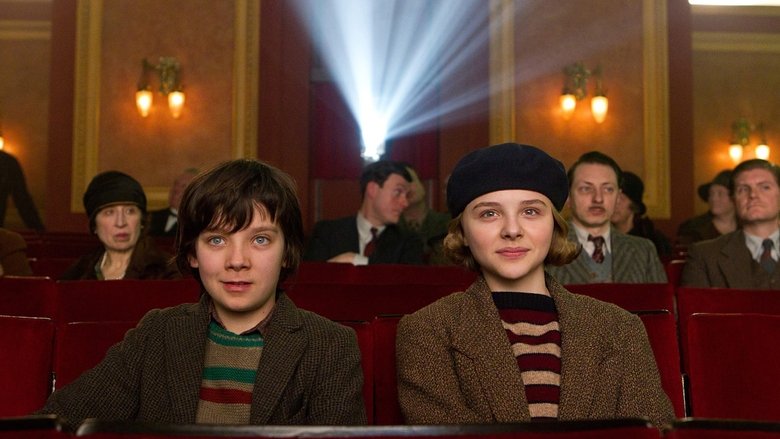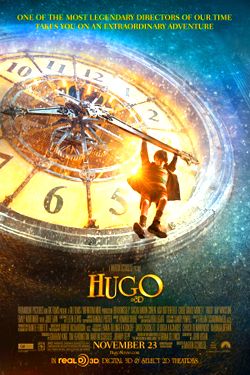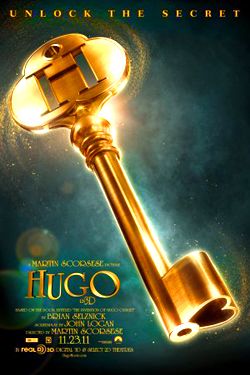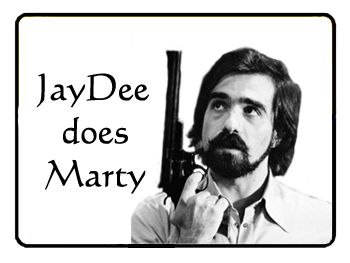← Back to Reviews

in
The third installment of JayDee Does Marty.
And the clockwork imagery that populates the entire film is extraordinarily charming. Given the intricate nature of the clockwork mechanisms it should perhaps come as no surprise to find Scorsese having such an affinity for its workings. As a director he comes off as such a craftsman that I can see why he'd appreciate the way in which all the gears and springs have to work together in conjuncture for the clock to function, similar to how all the different departments and individuals on a movie production have to come together to produce a finished project. Oh and with all the clockwork on show I imagine this is like a porno to Guillermo del Toro! The Parisian train station where the vast majority of the film is set is a terrifically evocative and richly detailed location; it's quaint, magical and 'oh so French' quality made me think that Amélie Poulain was likely to pop into shot at any moment. It's a realistic setting, but one that is also slightly on the fantastical side. That's on the surface but it's also a great creation behind that exterior, a complex maze of passages and rooms hidden from the public where Hugo lives and works. It sort of reminded me of the scenes in Star Trek with characters in the jefferies tubes, moving within the heart of the starships.

|

|
Year of release
2011
2011
Directed by
Martin Scorsese
Martin Scorsese
Written by
John Logan (script)
Brian Selznick (novel)
John Logan (script)
Brian Selznick (novel)
Starring
Asa Butterfield
Chloe Grace Moretz
Ben Kingsley
Sacha Baron Cohen
Helen McCrory
Asa Butterfield
Chloe Grace Moretz
Ben Kingsley
Sacha Baron Cohen
Helen McCrory
Hugo
Plot - Paris, 1931. Hugo Cabret (Butterfield) is a young orphan boy living in the walls of the Gare Montparnasse train station. His father was a man with a great knack for fixing clocks and other mechanical devices. When he tragically died in a fire, Hugo was taken in by his uncle Claude who put him to work keeping the train station clocks running. Back when his father was still alive, the two were fascinated by a broken automaton that his father had found abandoned in a museum, attempting to get it back working. Believing that the automaton holds a final message from his father Hugo now continues with these attempts, stealing whatever odds and ends he can get his hands on to aid him. However his thefts bring him to the attention of Papa Georges (Kingsley), a toymaker and shopkeeper in the station, who takes a notebook from Hugo that his father wrote and drew in. In his attempts to get it back, Hugo meets the acquaintance of Georges' god-daughter Isabelle (Moretz) who promises to help him and together they set off on an adventure, one that will hold some surprising discoveries about Papa Georges' past and reveal a startling connection between him and Hugo's automaton.
Following in the footsteps of After Hours this was another film where I really wasn't sure what exactly to expect. Martin Scorsese, king of the gangster film, making what essentially appeared to be a kiddie movie? I had my reservations. Also in the footsteps of After Hours however, Marty once again came along and blew those reservations away. I found Hugo to be an absolute delight, just an immensely charming and magical little film.
At one point in the movie, Chloe Grace Moretz's character says to young Hugo, “Thank you for the movie today....it was a gift.” And that seems to aptly sum up the sentiments that Martin Scorsese is attempting to convey with Hugo. There can be very few people on the planet who can match Marty in terms of passion and knowledge of the history of cinema. And this certainly feels like his love letter to cinema and its early pioneers, led by George Méliès. Some of the moments that he comes up with are just wonderful. The scene in which Hugo introduces Isabelle to the magic of the movies has got to be one of my favourite scenes in quite some time. It's magical stuff, and Moretz's joyous facial expressions are just a delight. It's not the only sublime scene to be found in Hugo. The sequences which see the automaton creak into life, and Méliès' drawings explode forth from their prison likewise put a smile on my face. Detailing the building blocks of cinema's early days also allows Scorsese to recreate some of the most iconic images from that time. The scenes featuring a recreation of an all-glass studio and the sets from Méliès' early productions are heartwarming and marvelous, largely because you can really feel the passion and reverence that Scorsese is putting into these scenes. In addition Scorsese also takes the opportunity to pay homage to some of early cinema's most enduring images; see the moment for example which has Hugo hanging onto the hands of a clockface in a obvious nod to the famous scene where Harold Lloyd dangles from a clockface in Safety Last!
Collaborating again with Robert Richardson, also the cinematographer on Shutter Island and The Aviator, once more proves fruitful for Scorsese who is able to deliver another movie that is just gorgeous to behold. Richardson cloaks the film in golden hues and bright tones and just creates such a sense of warmth that fits perfectly with the story. It's no surprise to discover that Richardson was awarded the Oscar for Best Cinematography at that year's Academy Awards. And some of the shots that Scorsese crafts are once again tremendous. The opening shot in particular is just an absolute treat. Opening on the gears and springs of a clock the image transitions by way of a slow fade to the bustling streets of Paris. The camera then sweeps across the city to its destination of the train station, along its platform, up and into the clockface, behind which we find young Hugo. It is just the first of many beautiful shots.
Film Trivia Snippets – I just mentioned the opening tracking shot of the film there. It was the very first shot designed for the film and it took a whole year to complete. It required 1000 computers to render each frame required for the shot. /// Martin Scorsese and Christopher Lee have been very good friends for a long time but had never worked together before Hugo. When Scorsese asked him about appearing in Hugo Lee's response was “It's about time!” /// This was Martin Scorsese's first film in 12 years not to star Leonardo DiCaprio. The last time that happened was with 1999's Bringing Out the Dead. /// During the early tracking shot that introduces us to the interior of the train station, there are appearances by characters who represent Django Reinhardt, James Joyce and Winston Churchill. /// When it came to how Ben Kingsley would portray the character of George Méliès, he based his characterisation on Martin Scorsese himself. /// The driving force behind the film was Martin Scorsese's young daughter Francesca who presented him a copy of Brian Selznick's book as a birthday gift hoping that he would make a film out of it someday. It was also her suggestion to have the film presented in 3D format. And when it came to how to direct the 3D cinematography Scorsese did so by wearing clip-on 3D lenses over his prescription glasses. /// During the flashbacks we see George Méliès staging his productions with lavishly colored sets and costumes. The real Méliès only used sets, costumes and make-up in grayscale, since coloured elements might turn out the wrong shade of gray on black and white film. Many of the prints were then hand tinted in post-production.
However perhaps the most impressive aspect of Scorsese's efforts is the performance he is able to coax out of young Asa Butterfield in the role of the eponymous Hugo Cabret. Butterfield, just 13 at the time of filming, does a superlative job at the heart of the film, proving to be a very mature and engaging presence. Together Scorsese and Butterfield make sure to pitch the character perfectly, making sure he doesn't fall into the trap of being too cute or too precocious. Oh and he's got to have the bluest eyes I've ever seen. As his partner-in-crime, or partner-in-adventure to be more accurate, Chloe Grace Moretz is also excellent. She just has such a delightful, endearing quality to her that I found it almost impossible to think that she was also the little girl in Kick Ass that was slaughtering everyone and throwing around the 'c word.' Some highly experienced adult actors also impress and bring a great warmth to proceedings, namely Ben Kingsley, Christopher Lee and Helen McRory. Kingsley and McRory also bring great emotion and sadness to their story thread about lost dreams and regrets. In the role of the Station Inspector, Sacha Baron Cohen is probably the closest the film comes to fulfilling its façade as a children's film, delivering a very broad and cartoonish creation that sees Cohen apparently channeling Peter Sellers' Inspector Clouseau. Even here however the character is revealed to have a heart and a gentler side through his bumbling attempts to romance Emily Mortimer's flower girl, Lisette.
Taking its narrative from Brian Selznick's novel “The Invention of Hugo Cabret”, the film has a lovely story at its heart; one that details both a young boy's grief over the loss of his father and his search for a final message from him, and an old man's regrets and longing for past glories. And as the story progresses these two threads are taken and skilfully woven together thanks to a few surprising and uplifting twists in the story. I loved the development of the Papa Georges character, initially building him up as this bitter, cantankerous individual before fleshing him out by exposing the reasons why he's like this and who exactly he is, forcing us to look at him in a different light and now eliciting a great deal of sympathy from the audience. Beyond the characters the film really is about the magic of cinema as I've already mentioned, and about finding and caring for the movies of the past. Scorsese has his own film company, The Film Foundation, who has made it its goal to preserve and restore films of the past, and bring them to the attention of audiences. In his own words he sums it up better than I ever could - “Movies touch our hearts and awaken our vision, and change the way we see things. They take us to other places, they open doors and minds. Movies are the memories of our lifetime, we need to keep them alive.”
Conclusion - The thought of Martin Scorsese making a family friendly kids film might seem odd on the surface but it's one that works out beautifully. As a film Hugo certainly has its flaws, and my mind was telling me it was miles away from being a perfect film. My heart however was telling me that it really wasn't all that far away at all. I just found it to be an utterly enchanting experience that looked just sumptuous, had a touching story and featured some terrific performances. I could be completely wrong but of the handful of Scorsese films I've seen now I get the feeling that this is his most heartfelt, the one that perhaps meant most to him. It's a profound and heartwarming little film.

